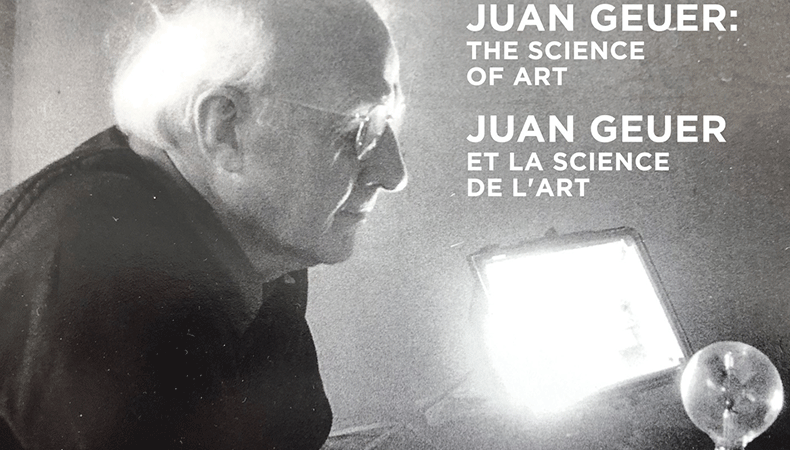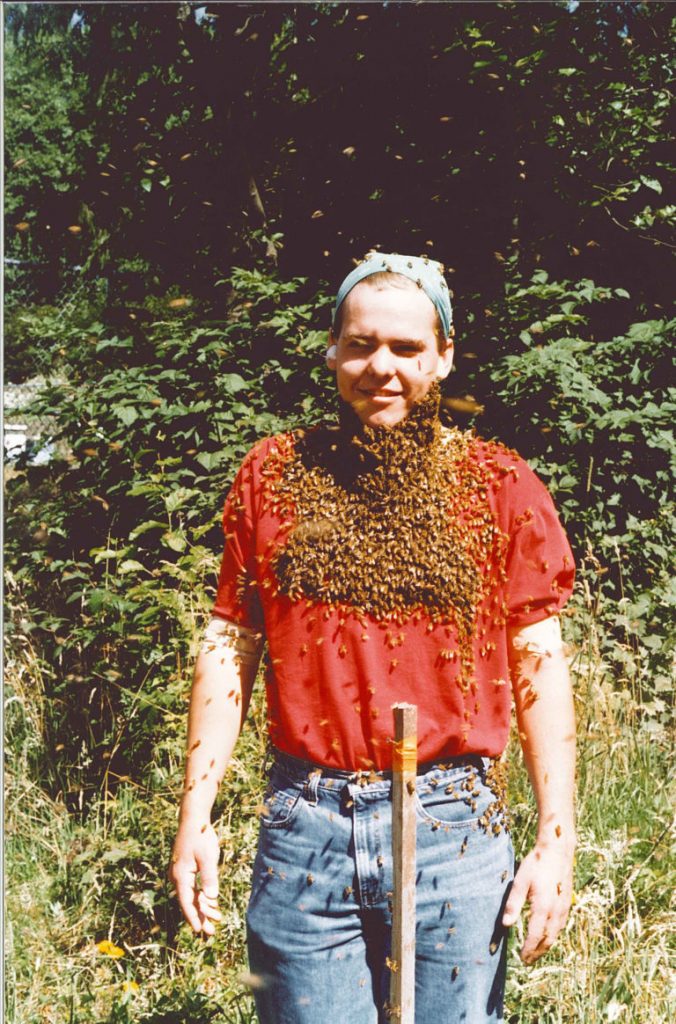If you’re in Ottawa on May 18, 2019 and available from 1 – 1:30 pm and have paid your entry fee to the Canada Science and Technology Museum, there’s a special talk. From a ‘Curiosity on Stage’ event page,
Have you ever wondered what it’s like to work in the fields of science, technology, engineering, and math? Curiosity on Stage is a series of short, interactive presentations that brings you face-to-face with researchers and innovators. Each week, a featured speaker delivers an engaging presentation followed by an interactive Q-and-A session. Curiosity on Stage invites you to learn directly from people working in the science and technology-related fields. Find out what they do and why it matters – and leave inspired by their stories of curiosity, overcoming obstacles, and innovation.
While everyone is welcome on the Demo Stage, this program is recommended for ages 10+.
This week: Juan Geuer: The Science of Art

[Speaker:] Wendy Moir, Ottawa Art Gallery
Wendy Moir earned her Master’s degree in art history from Carleton University and a Bachelor of Arts in art history and English literature at Queen’s University. She is passionate about art education and has taught visual literacy at galleries in Kingston, Halifax, and Ottawa since 2003. Wendy currently teaches Canadian art history in the diploma program at the Ottawa School of Art and is an educator at the Ottawa Art Gallery.
This week, Wendy will be showcasing the work of Juan Geuer. Juan Geuer’s art, along with seven other artists he either collaborated with, influenced, or worked with in parallel, is showcased in the Ottawa Art Gallery exhibition Carbon + Light: Juan Geuer’s Luminous Precision. This presentation discusses his life in the National Capital Region and his ground-breaking artwork that sits at the threshold between science and art.
I’d never heard of Juan Geuer before but the title for the current exhibition of his work at the Ottawa Art Gallery immediately caught my attention, CARBON + LIGHT
JUAN GEUER’S LUMINOUS PRECISION. Here’s the description from the exhibition webpage,
March 9 – August 18, 2019
Canadian artist Juan Geuer’s groundbreaking work sits in the threshold between science and art.
It bridges the human condition, in all its various states, and the carbon-based ecosystems and oxygenated atmospheres upon which we depend.
The exhibition Carbon + Light celebrates this artist’s significant legacy as a fearless truth seeker. Through his inventive approach to installation, he pointed out the onset of the Anthropocene long before the term emerged to denote the geological period in which we now find ourselves embedded. Here, Geuer’s work will be in dialogue with artists with whom he either collaborated, influenced, or worked with in parallel, from Michael Snow to Catherine Richards.
The exhibition will also showcase the importance of Ottawa as the site within which Geuer’s surprising practice emerged, suggesting that time and location were instrumental to his ability to develop his unique investigation.
CURATOR
Caroline Seck Langill
Here’s one of the images and my favourite of those featured on the gallery’s Juan Geuer exhibition page,

It’s free and you can find out more about the Ottawa Art Gallery here.
The National Gallery of Canada (also in Ottawa) Has collected some of Geuer’s work and has a biography,
Juan Geuer’s goal is “to study our perception beyond science and art and to investigate our creative ability for adapting new visions”.
For Juan Geuer science is an activity as creative, inspired, and dependent upon perception as art. He is interested in the parallels between scientists and artists and their respective involvements with observation — their attempts to view nature in ways ever more complete, the scientist with apparatus, formulae and statistics, the artist by attention and understanding of the filters that colour perception.
Juan Geuer was brought up in a family of Dutch artists and became himself an artist, working first in glass in the 1940s and later turning to easel painting and murals. He left Holland with his family just before the beginning of World War II and immigrated to Bolivia.
By the time he came to Canada in 1954, he had traveled widely and tried his hand at several professions. In Canada, he worked as a draftsman at the Dominion Observatory of the National Research Council through the late 50s, the 60s and the70s, where he was exposed daily to the beauties and intricacies of science. Having only a little academic background in science, he learned from the scientists and, always an independent thinker, drew his own conclusions. Geuer maintains that both science and art are creative endeavours requiring of their practitioners an open-mindedness and a willingness to accept nature’s surprises.
By the 1960s, Geuer had become disenchanted with the idea of producing art as a commodity for sale to a limited public; he began to seek alternatives that might better reflect the creativity in everyday life. Eventually he began to view his scientific activity as inseparable from his art. He turned from painting to making more conceptual work in the early 1970s. Juan Geuer’s interest in finding a meeting ground between science and art is clearly stated as a mission of his company, The Truth-Seeker Company, formed in 1973. Geuer sees science as a theoretical network of systems that can only be verified by referral to the real world, or nature. But that which we know as nature is still only a concept based on the perceptions of our senses. Science can extend sensory perception by instruments that enable us to observe and analyze nature, thereby enriching our understanding of it.
Conversely, art for Geuer requires an open attitude to nature, a willingness to accept what is given, if the artist is to act “as the mirror which transmutes itself into as many colours as exist in the things placed before it,” (Leonardo da Vinci’s quote on an artist’s purpose). Geuer reaffirms in his art the necessity of humanity maintaining an honest dialogue with nature.
Some of Geuer’s works incorporate scientific apparatus. Other works use or analyze natural phenomena, like the colours of polarized light or earthquake activity. For Geuer, the equipment and methods of science can be useful to the artist who cares to understand them and to use them to allow the ordinary person entry into the universes that science can reveal.
In Karonhia, 1990, a work owned by the National Gallery, a simple scientific device is at work in aid of the observation of nature – mirrors. The mirrors are positioned with precision to reflect the sky, providing an opportunity for observation of its changing colours and weather conditions. Designed in response to the conditions of the architecture, Karonhia which means “sky” in the Mohawk language, frames and reflects the sky in four directions from four observation points, providing a constant daytime show of natural visual phenomena that draws visitors’ attention to an aspect of nature that is sometimes taken for granted.
H20, another work in the Gallery’s collection incorporates sophisticated and original equipment used for the observation of another natural phenomenon, water. Laser light is passed through a drop of water as it forms, swells and falls from a controlled source. The water drop acts as both lens and image. Its image is projected onto a wall by the laser light passing through it, where the viewer can watch it, large-scale. The magnification is itself fascinating – one can see the surface tension of the drop, a force that for Geuer is a dynamic and mysterious force, believed to be based on hydrogen bonding, that permeates all biological processes. One might also see bacteria and other matter if they are present – each drop becomes a unique microcosm, observable for the duration of its existence. In H20, Geuer brings the unimaginable into a form that can be perceived and contemplated.
Geuer has extensively exhibited his work both within Canada and internationally, in solo and group exhibitions. Key among his exhibitions were his showing of several pieces at the List Visual Arts Centre of MIT in 1986 and his solo exhibition in Rotterdam at the Museum Boymans-van Beuningen in 1985.
I’m going to end this post with a link to a film made by Ed Folger about one of Geuer’s most seminal works, WIS (Water in Suspense) but first, there’s this excerpt from a May 7, 2009 obituary on Canadian Broadcasting Corporation (CBC) online news,
…
Ed Folger, who is finishing a video that documents one of Geuer’s pieces, said Geuer was intent on showing people the underlying rhythms of the earth and making the imperceptible visible.
Geuer saw art in lasers and swinging pendulums and used them, along with mirrors, in many of his creations.
“If you just look at a drop of water, you can’t see the movement of the molecules, but if you put a laser through it, these fabulous patterns are projected out,” said Folger.
One of Geuer’s seminal pieces — a seismometer that records motion — is permanently installed at the Ottawa Art Gallery.
“Wonderment! He kept using that word over and over again. Wonderment. It’s what people should feel,” said Folger.
Unfortunately, much of Geuer’s work is too complicated to be shown often, said Folger.
Geuer’s website describes one creation, Hellot Glasses, made in 1996, as small mirrors that allow viewers to “live vicariously in one another’s gaze.”
In an interview he gave at the age of 91, Geuer gave a hint of how it might feel to look through his own gaze.
“Every day, I get up with this wonderful feeling, and I think I can do something new today, something nobody else has done. I will find something,” he said.
Here’s a link to Folger’s film, Water, Light and Chaos: Art by Juan Geuer. It’s on Vimeo and it’s about 20 minutes long.








